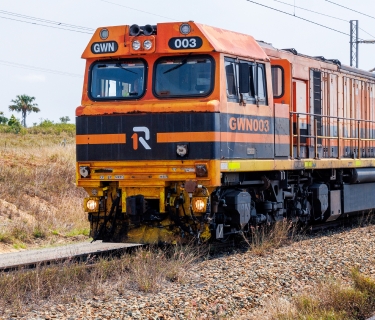- By TOP CHINA FREIGHT
- September 28, 2025
- Rail Freight, Shipping
Table of Contents
The average speed of freight train in China plays a crucial role in shaping logistics efficiency, delivery timelines, and overall supply chain performance. Businesses that depend on rail freight must understand not only the speed itself but also the many factors that influence it. From infrastructure and cargo type to customs clearance and route conditions, every detail matters. This guide explains how China’s freight train speed impacts global trade, how it compares with other transport modes, and what businesses can do to optimize shipments.

What is the average speed of freight train in China?
In China, the average speed of freight trains generally ranges between 40–60 km/h, depending on cargo type, rail line conditions, and scheduling. On dedicated freight corridors, such as those connecting inland industrial zones to ports, speeds may reach 80–120 km/h for priority goods. However, bulk commodities such as coal or raw minerals often move slower due to heavier loads.
| Train Type | Average Speed (km/h) | Typical Cargo | Transit Focus |
|---|---|---|---|
| Standard freight train | 40–50 | Coal, minerals, construction | Heavy bulk goods |
| Mixed cargo train | 50–60 | Containers, electronics | General trade shipments |
| Express freight service | 80–120 | High-value, urgent goods | Fast supply chain delivery |
Therefore, while the figure may vary, businesses should plan around the average 50 km/h speed for general shipments unless express services are chosen.
Why does train speed matter for supply chains?
The average speed of freight train in China directly affects delivery schedules, inventory management, and competitiveness in international trade. For example, a slower freight schedule may increase warehousing costs, while a faster one allows just-in-time manufacturing.
Moreover, rail freight bridges the gap between sea freight (cheaper but slower) and air freight (fast but costly). Companies trading with Europe through the China–Europe Railway Express rely heavily on predictable transit times enabled by average freight speeds.
How does train speed compare with other transport modes?
Rail freight is not the fastest mode, but it strikes a balance between speed and cost.
| Mode of Transport | Average Speed | Transit Time (China–Europe) | Cost Level | Best For |
|---|---|---|---|---|
| Sea freight | 30 km/h (ships) | 30–45 days | Low | Bulk cargo |
| Rail freight | 40–60 km/h | 14–20 days | Medium | Mid-value cargo |
| Air freight | 800 km/h | 3–7 days | High | Urgent, high-value goods |
As shown, the average speed of freight train in China allows delivery in half the time of sea freight while maintaining significantly lower costs than air.
What factors influence the average speed of freight trains?
High-speed freight corridors and modern signaling systems improve efficiency.
Heavy goods reduce speed, while lighter containerized cargo moves faster.
Passenger trains often get priority, causing delays for freight.
International routes face inspections that affect schedules.
Floods, snow, or extreme heat can reduce safe operating speeds.
Can businesses improve delivery speed through planning?
Yes, businesses can significantly influence transit speed through careful planning. Selecting the right freight forwarder, booking express rail services, and consolidating shipments strategically help maximize efficiency.
Additionally, digital supply chain tools offer real-time tracking of train movements. This visibility allows businesses to anticipate delays and adjust logistics accordingly. For industries like automotive or electronics, where production relies on punctual deliveries, such planning is essential.
What role does technology play in improving train speed?
China has invested heavily in smart rail systems that improve freight efficiency. Automated scheduling, advanced signaling, and predictive maintenance reduce delays. For instance, AI-based logistics platforms can reroute trains to less congested tracks, boosting average speed.
Furthermore, electric locomotives have replaced older diesel engines, offering faster acceleration and improved sustainability. These upgrades not only enhance train speed but also reduce carbon footprints compared with road or air transport.
How do international routes affect average freight speed?
Domestic freight trains in China may operate faster than international ones due to simpler procedures. Cross-border shipments to Europe or Central Asia often face customs inspections and rail gauge changes, which reduce overall speed.
| Route | Transit Time | Average Speed | Key Challenges |
|---|---|---|---|
| China Domestic (inland to port) | 1–3 days | 50–60 km/h | Congestion, scheduling |
| China–Europe Express | 14–20 days | 40–50 km/h | Customs, multiple borders |
| China–Central Asia | 7–12 days | 45–55 km/h | Infrastructure limits |
Nevertheless, these services are still much faster than sea freight, offering a strong alternative for mid-value trade.
Case Study: Electronics Manufacturer Using Rail Freight

A Chinese electronics company exporting to Germany previously relied on sea freight, facing long delivery times of over a month. By switching to the China–Europe Railway Express, shipments now arrive in about 16 days, thanks to the average speed of freight train in China at 45 km/h.
This shift reduced warehouse storage costs by 20% and enabled faster product launches in the European market. While costs were slightly higher than sea transport, the overall efficiency gains made rail freight the optimal choice.
What are the pros and cons of freight train transport?
| Pros | Cons |
|---|---|
| Faster than sea freight | Slower than air freight |
| Lower cost than air freight | Border inspections may cause delays |
| Environmentally friendly option | Limited flexibility compared to trucking |
| Reliable schedule on major corridors | Not ideal for very short distances |
| Suited for mid-value and container cargo | Speed varies by cargo and route |
Thus, companies should weigh these pros and cons based on shipment value, delivery urgency, and destination.
Should companies prioritize speed or cost?
The decision depends on cargo type and business strategy. High-value products such as electronics, automotive components, or seasonal goods benefit from rail freight speed. Conversely, heavy commodities like steel or coal may be better suited for sea freight due to cost efficiency.
Balancing speed and cost ensures optimized logistics and improved competitiveness in global markets.
Conclusion
The average speed of freight train in China generally ranges between 40–60 km/h, offering a balance between cost efficiency and delivery speed. Although slower than air freight, it provides a much faster option than sea shipping while remaining cost-effective. For many businesses, especially those shipping mid-value goods to Europe, rail freight represents the ideal compromise. With ongoing infrastructure upgrades and smart technology, train speeds will likely improve further, strengthening China’s role in global supply chains.
Need a Shipping Quote?
If you want expert guidance and peace of mind, our team is ready to assist.
TJ China Freight offers tailored solutions to help businesses of all sizes ship more reliably from China.

FAQ
Q1:What is the fastest freight train speed in China?
Some express freight services reach up to 120 km/h, mainly for urgent goods.
Q2:How reliable are freight train schedules in China?
Schedules are generally reliable, though passenger trains often get priority.
Q3:Does weather affect freight train speed?
Yes, heavy rain, snow, or extreme heat can reduce safe operating speeds.
Q4:Can perishable goods be shipped by freight train?
Yes, refrigerated containers allow safe transport of perishable items.
Q5:How does customs clearance affect train speed?
Border checks and rail gauge changes may add delays on international routes.
